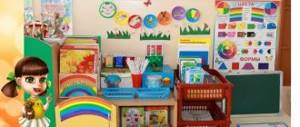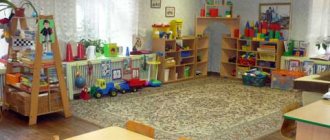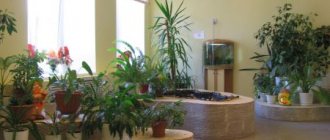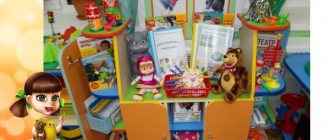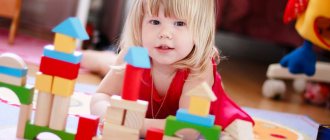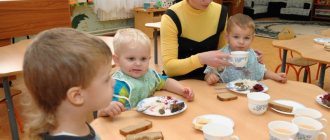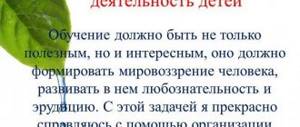The importance of a developing subject-spatial environment in the senior group of preschool educational institutions
The task of any preschool educational institution (DOU) is to create conditions for the development and upbringing of children, maintaining their health in a safe and comfortable environment. The most important component of this task is the organization of a subject-spatial environment that corresponds to the components of the educational and developmental process carried out by teachers. It has long been proven that a child’s development occurs with his active participation in a variety of activities. For senior group students, the following areas are highlighted:
- training and development activities;
- performing practical and creative work;
- role-playing games;
- basics of labor activity;
- physical education classes;
- music and choreography lessons.
The administration of a children's educational institution, teachers and educators must create a multi-component educational environment for a preschooler, which takes into account different aspects of organizing the process of raising and developing a child. This:
- developing subject-spatial environment;
- organizing interaction with teachers;
- communication with peers;
- the preschooler's attitude to the world around him and to himself.
The subject environment in the group should correspond to the age and interests of the students
Children should live in a world of beauty, games, fairy tales, music, drawing, fantasy, and creativity.
V. A. Sukhomlinsky
Principles of constructing a subject-development environment
The subject-spatial environment in the older group serves the development of children's activities, primarily play. Indeed, during play, the leading activity of preschool children, cognitive motivation develops, which is the basis of educational activity. The subject-spatial developmental environment must correspond to the zone of proximal mental development of a 5-6 year old child - the formation of prerequisites for educational activity.
The entire time a child is in an educational institution is filled with one activity or another, and it is necessary that the entire environment surrounding the preschooler contribute to his development. In this case, the conditions of safety, versatility and variability of equipment must be met.
Principles of organizing the subject-spatial environment in the senior group:
- The environment must perform educational, developmental, nurturing, stimulating, and communicative functions. But the most important thing is that it should work to develop the child’s independence and initiative, which is important for older preschoolers.
- Flexible and variable use of space is necessary. The environment should serve to meet the needs and interests of the child.
- The shape and design of the items are focused on the safety and age of children.
- Decorative elements should be easily replaceable and mobile.
- It is necessary to provide space in the group for children's experimental activities.
- The color palette should be represented by warm, pastel colors.
- When creating a developmental space in a group room, the leading role of play activity is taken into account.
- The subject-developmental environment of the group changes depending on the period of children’s education.
- It is important that the subject environment has the character of an open, non-closed system, capable of adjustment and development. The objective world surrounding the child must be replenished and updated, adapting to the new developments of older preschool age.
- An important task is to develop in older preschoolers the ability to interact with representatives of the opposite sex. The environment should be organized so that girls play with boys.
The created subject-development environment evokes in pupils a feeling of joy, a positive attitude towards kindergarten, a desire to attend it and learn new things
The environment surrounding preschoolers in kindergarten should ensure the safety of their lives, promote health, and also contribute to the development of the cognitive and creative abilities of pupils. This takes into account the inclinations, interests and activity level of each child.
When assessing the subject-developmental environment for pupils of the senior group, pay attention to:
- general design of the room, design aesthetics, availability of a variety of equipment for various types of activities;
- organization of children's living space (presence of light partitions, screens, modules, poufs).
- toys and materials that should ensure both playful and productive activities of pupils.
Subject-game environment presentation for a lesson on the topic
Slide 1
Subject-game environment Completed by: Svetlana Medvedeva.
Slide 2
Subject-based play environment for preschool children The concept of subject-based play environment is considered in pedagogy as a narrower characteristic of the environment, as a factor that stimulates, guides, and develops the child’s activity. It influences the development of the individual in a broad sense and the formation of narrower qualities, such as independence, activity, etc.
Slide 3
Organization of a subject-play environment and its influence on the development of children’s gaming skills When designing a subject-play environment in a group, first of all, we focus on the goals of development and education of children, based on the essence of the requirements of modern pedagogy, the active role of the child and adult in this process.
Slide 4
To build a developmental environment in preschool educational institutions, the following principles are distinguished: the principle of openness; flexible zoning; stability - dynamism of the developing environment; multifunctionality
Slide 5
The principle of openness to society and openness of one’s “I” presupposes the personalization of the environment of each group. For this purpose, groups have organized photo exhibitions “This is what we are like” and family albums.
Slide 6
The principle of flexible zoning is to organize various intersecting areas of activity. This allows children, in accordance with their interests and desires, to freely engage in different types of activities at the same time, without interfering with each other: physical education, music, drawing, experimenting, dramatizing fairy tales. arrange dramatization games.
Slide 7
The principle of stability and dynamism of the development environment is closely interconnected with the principle of flexible zoning. The subject-developmental environment of the group changes depending on the age characteristics of the children, the period of study, and the educational program. If there are more boys in the group, then the group has more construction sets, blocks, cars, which allows children to build houses, bridges, arches, garages not only on the table, but also on the floor. If there are more girls than boys, then games of “family,” “hospital,” and “shop” play out more often.
Slide 8
The principle of multifunctionality of the objective world is implemented with the help of various modular equipment, which is equipped in all premises of the kindergarten. The use of modules along with construction sets, mosaics, and physical education equipment (hoops, balls, jump ropes) promotes the development of imagination and the sign-symbolic function of preschoolers’ thinking.
Slide 9
Subject-based game environment in: Junior group Middle group Senior preparatory group
Slide 10
junior group “A small child is a great miracle, an eternal mystery, a fragile bridge into our future and past at the same time.” In accordance with the plot-forming functions, three types of gaming material (toys) are distinguished:
Slide 11
“Objects of operation” are toys that imitate real objects - tools, tools, means of human activity that allow you to recreate the meaning of a real action (for example, a toy cup, iron, hammer, steering wheel, etc.) “Toys - characters” are various kinds of dolls, figures of people and animals. In terms of functions in the game, this also includes game material representing game attributes specific to a character (role), for example, a white doctor’s cap, a fireman’s helmet, etc. “Markers (signs) of the play space are toys, play material indicating the place of action, the environment in which it takes place (for example, a toy stove, a house-teremok, a rocket frame, a frame depicting the bow of a ship or the front wall of a bus, etc. .p.) From the age of three, children become more demanding about the “similarity” of toys to real things.
Slide 12
The organization of the developmental environment in the middle group is structured in such a way as to make it possible to most effectively develop the individuality of each child, taking into account his inclinations, interests, and level of activity. middle group
Slide 13
The playing area should be located on a convenient side of the group. This allows you to create conditions for the creative activity of children, the development of imagination, the formation of gaming skills, the implementation of gaming plans, and the cultivation of friendly relationships between children.
Slide 15
Senior group In senior preschool age, the intellectual, moral-volitional and emotional spheres of the child’s personality intensively develop. Children begin to feel like elders among other pupils, and the teacher’s task is to help them understand this new state. Taking into account the characteristic need for older preschoolers for self-affirmation and recognition of their capabilities by adults, the educator must create conditions for their development of independence, initiative and creativity.
Slide 16
The subject-development environment in the senior group must meet the principles of activity, independence, creativity, and dynamism. The group also has designated areas for role-playing games - “Hospital”, “Family”, “Hairdresser”, “Atelier”. free up a significant area and move some of the gaming equipment to the bedroom. This solves the problem of limited group space.
Slide 17
Preparatory group All group space should be distributed into CENTERS that are accessible to children: toys, teaching material, games IN THE CENTER of privacy - behind a screen, they can leaf through their favorite book, look at photographs in a family album and just sit and relax from the children's group. Wooden portable screens and stands can also serve as walls for children’s individual games. Using them, a child can make a room for play, thus fencing off from the common space, creating his own little world. In this simple way, the personification of the environment is achieved, i.e., the creation of “your own” personal space.
Slide 18
In addition, the organization of an object-based play environment must meet the following requirements: take into account the patterns of development of play activity, meet the pedagogical tasks of raising children of different ages, be developmental in nature, meet the needs and level of development of the child’s cognitive sphere, i.e. be inexhaustible, informative, meet the needs in novelty and transformation.
Slide 19
The subject-based play environment in kindergarten groups should be organized in such a way that every child has the opportunity to do what he loves.
Slide 21
Literature R.A. Kiryanova The book provides recommendations for organizing a developmental environment, taking into account age characteristics, the period of education and the individual capabilities and abilities of each child. The principles of constructing a development environment are revealed and photographic material is presented. The book is intended for teachers, speech therapists, senior educators, as well as parents.
Slide 22
Thank you for your attention
Types of corners and centers in the senior group
When planning the placement of equipment and furniture in kindergarten premises, it is necessary to take into account the flexible division of space into separate zones in order to provide different types of activities for preschoolers. In the premises for older children, several areas can be distinguished.
The group room in a kindergarten is usually small, so every meter of space should be used rationally.
Sports section
Here there is sports equipment, both factory-made (jump ropes, balls, ropes, clubs, hoops), and those prepared by teachers together with parents (flags, ribbons, bags filled with sand, handkerchiefs). It is necessary to provide special equipment for individual exercises with children to prevent flat feet (massage track), improve posture, and develop the eye.
A sports corner in a group, in addition to standard equipment, may contain a card index of outdoor games, riddles, cards and visual aids for sports
Productivity Corner
This corner should have good lighting. On the shelves or in the cabinets there are tools for children's creativity:
- various types of paper,
- cups with pencils and markers,
- paints,
- multi-colored wax crayons,
- plastic material for modeling,
- pieces of different fabrics for appliqués,
- all kinds of materials for making crafts,
- different scissors,
- hole punchers,
- staplers.
It is important that all materials are brightly and attractively decorated and neatly laid out. Children should be able to use any material in their creativity. For older preschoolers, the tables are arranged so that the children can work together if they wish. There should also be samples for drawing, patterns for making crafts, and samples for modeling. It is imperative to provide a stand to demonstrate the completed work of students.
In the productive activity corner, children can draw, sculpt, and make appliqués
Role-playing games center
While playing, preschoolers develop imagination, creativity, and ingenuity. By simulating various situations, they study the world around them and the relationships between people. Playing with peers helps develop communication skills and foster friendly and respectful relationships in the group. To ensure that children have a choice, the center should have a large number of toys available. The composition of the subjects changes periodically to maintain the children's interest.
Table: types and purposes of toys for older preschoolers
| Types of toys | Purpose |
| Plot-shaped | They correspond to the image of a living creature (dolls, bunnies, bears) and participate in staging the game plot during children's games. |
| Technical | These toys correspond to technical devices: all types of transport, means of communication and communication. |
| Toys for fun | Funny people, animal figures. May contain some unexpected movement, surprise. |
| Masquerade | Used by children to enter into some kind of image: the tail of a bunny or fox, the mustache of Basilio the cat. |
| Musical | Necessary to satisfy children's interest in sounds. |
| Tabletop | Designed for children's development. |
| Theater | Such toys develop speech, imagination, and ingenuity. |
| Construction materials and designers | Development of attentiveness, intelligence, spatial imagination. |
All toys are placed in such a way that preschoolers can freely play with them and put them away
Theater zone
In the senior group, you can organize different types of theater:
- finger,
- desktop,
- palmar,
- theater on plates,
- theater on spoons or sticks,
- theater of mittens or gloves,
- theater on flannelgraph,
- beanie theater,
- shadow theater,
- use of Bibabo dolls,
- puppet show,
- staging fairy tales by children themselves.
In addition to puppets for productions, there should be 2 screens in the theater area: small and large. You can use a screen or a large mirror as decoration. For tabletop performances, these can be panoramic books.
Preschoolers enjoy participating in dramatizations of fairy tales or stories; they can improvise the actions of their favorite characters, come up with a game to repeat the actions of adults, or act out books they have read about fairy-tale animals. Participation in theatrical performances develops speech, fine and gross motor skills, trains memory and imagination. The experience of joint activities with peers and adults contributes to the development of communication skills and socialization of preschoolers.
The theater area is conveniently located next to the music area.
The theater area in the senior group includes characters from various types of theater and various attributes
Music corner
Playing music sometimes requires solitude and concentration. It would be desirable to be able, if necessary, to isolate this part of the group with a light screen. The design of this area should be attractive to children and accessible for viewing. At the same time, it is necessary to teach students to be careful and careful with the equipment, as it may become unusable.
In addition to the musical instruments themselves, this corner houses audio and video equipment (slides, filmstrips, audio cassettes) and technical equipment (tape recorder, TV, stereo system). There are also manuals for didactic games aimed at developing an ear for music. You can put an album of songs with illustrations (the images correspond to the lyrics of the song), and place portraits of famous composers. Just as in other zones, the material changes periodically to ensure that children retain the novelty of their perception.
In the music corner, older preschoolers enjoy playing instruments and singing songs
Speech development zone
This zone should have a selection of plot and subject illustrations for retellings, didactic games for the development of sound culture and grammatical structure of speech, increasing vocabulary, and mnemonic tables. Didactic material can be either factory-made or prepared by the teacher. To practice correct pronunciation, purchase albums with articulation exercises and tongue twisters. There should be mirrors for children's individual articulation lessons. In the older group, in this area there is a magnetic board with the alphabet.
Older preschoolers already know letters and are learning to write words on the board
Book corner
The book corner is often combined with a speech development area. It simultaneously houses 10–12 books on the following topics:
- fairy tales,
- poems and stories on a patriotic theme,
- stories about animals and plants,
- books studied in class,
- humorous books,
- books that children bring from home.
Books should have many illustrations, be colorfully designed, and you can use toy books. The average length of time a book stays in a corner is 2 weeks, but it can be adjusted depending on the interest of the children. There are also albums for viewing, children's magazines, and portraits of writers. You can organize a small library of little books. For older children, you can organize exhibitions telling about the work of an individual writer, a specific genre (fairy tale, humorous story, poetry) or even one book.
The design of the book corner in the senior group should be bright and attractive to stimulate preschoolers’ interest in reading
The patriotic education corner can be combined with a book corner. Patriotic education in kindergarten is aimed at developing love for one’s homeland, native land, and family. An example of the design of such a corner is presented in the article by Sharova E.V. “Patriotic education in a preschool educational institution.”
The patriotic corner introduces children to the symbols of our country, hometown, village, and folk crafts.
Math corner
This corner contains didactic material for the formation of mathematical knowledge and the development of logic. It may contain:
- carpet "Larchik" according to Voskobovich,
- logical blocks of Dienesh,
- sets of colored Cuisenaire counting sticks,
- Nikitin cubes,
- various construction sets and board games for solving logic problems and counting.
Currently, there is a selection of printed workbooks and many educational aids for preschoolers. You can use materials made by yourself.
In the mathematics corner there are various manuals and games for developing counting skills in preschoolers
Center for Experimental Activities
The group's research center is located away from the sports and play areas. There should be a place reserved for a permanent exhibition of rare objects (shells, stones, crystals), unusual natural materials, and collections. Such a center should be provided with protective clothing for preschool children, equipment and materials for conducting experiments. What equipment can be selected for preschoolers of the senior group is described in detail in the article by Galina Evchenko “Organization of a subject-spatial environment for experimentation in a preschool institution for different age groups.”
At the experimentation center, preschoolers conduct simple experiments, which develops children’s logical thinking and stimulates cognitive activity.
Photo gallery: equipment of the experimentation center
The equipment of the experimentation center should be varied, but most importantly - safe
Preschoolers conduct all experiments under the strict supervision of the teacher.
Prepared instruments should always be clean
In the center of experimentation, preschoolers develop primary natural scientific concepts
Construction area
This area features a large variety of construction kits. Preschoolers can independently create various buildings according to their schemes and ideas. This zone can be combined with a corner for studying traffic rules, the design of which requires models of houses and streets, traffic lights, and traffic signs. For role-playing games according to traffic rules, it is convenient if the pedestrian crossing is marked on a special rug or floor covering.
The construction area can be combined with a corner for studying traffic rules
Corner of nature
The organization of this zone is intended for environmental education of preschool children. Such a corner awakens children's interest in wildlife and its inhabitants. Daily observation of plants and animals, participation in their care develops children’s sense of empathy for living beings, creates a more favorable atmosphere in the group and increases the psychological comfort of pupils. What plants and animals are recommended to be placed in a corner of wildlife and what conditions must be observed are described in the article by Volodkovich Galina “The role of a corner of nature in the environmental education of children of senior preschool age.”
In the ecological corner, children learn to care for plants, which fosters respect for nature
Zone of organization of labor activities
Children of the older group have work responsibilities. They take care of themselves: dressing, undressing, preparing a workplace for classes, helping in the dining room, and can carry out some instructions from the teacher. In addition, group duty is organized. Duty not only develops practical work skills, but also develops responsibility, the ability to work in a team and teaches children to be independent. You can organize duty in the dining room, caring for plants and animals, and organizing classes. In the corner for organizing work activities there should be a duty screen, protective clothing (aprons, oversleeves, scarves), equipment for performing the duties of the duty officer (containers for watering plants, sponges for cleaning).
A duty screen, protective clothing and equipment for performing the duties of a duty officer are placed in the work activity corner.
When changing the working environment in a group, older preschoolers must be involved in the transformation of the environment. With the help of screens or screens, children can change the spatial organization of the room according to their plan, highlighting the area in which the lesson will take place.
